Looking to add gentle exfoliation and a pop of color to your next project? Small, spherical jojoba beads are a great option. Created from jojoba oil, jojoba beads (sometimes referred to as jojoba esters) are odorless, firm and come in a various colors and sizes. Jojoba beads can be used in various projects including melt and pour, scrubs and cold process.
 Love the cheery orange color of jojoba bead shown above? This new color will be available soon!
Love the cheery orange color of jojoba bead shown above? This new color will be available soon!
Jojoba oil is a luxurious liquid wax derived from the seed of the Jojoba shrub. Jojoba oil is made of up various long chain molecules. These molecules are transformed from a liquid to a solid wax by processes called hydrogenation or transesterification. This firm wax is referred to a jojoba ester, also known as a jojoba bead!
Jojoba esters are very similar in structure to skin’s nature oil, referred to as sebum. Because jojoba beads are made from a liquid wax, they are bio-degradable and sustainable. Jojoba beads should not be confused with plastic microbeads that are used in some bath and body products.
Commonly used as an exfoliant, jojoba beads are suitable for sensitive skin due to their spherical shape. While some exfoliates are jagged and can create microscopic tears on the skins surface, jojoba beads are smooth and gentle. The smooth edges of jojoba beads make them a great choice for facial scrubs, as microscopic tears can contribute to premature aging. 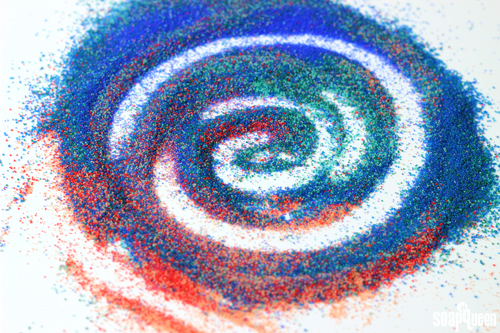 Small jojoba beads are perfect for creating scrubs or facial cleansers, while medium and large jojoba beads are suitable for body products. In the Sea Salt Foot Scrub, purple jojoba beads are added to give color and extra exfoliation. Forest green jojoba beads create the allusion of grass in the adorable Simple Easter Scrub. If you are looking for a solid scrub, the Fruity Holiday Solid Sugar Scrub uses melt and pour and jojoba beads to create small, scrubby cubes. Keep your eyes on the blog for a new scrub featuring jojoba beads later this week!
Small jojoba beads are perfect for creating scrubs or facial cleansers, while medium and large jojoba beads are suitable for body products. In the Sea Salt Foot Scrub, purple jojoba beads are added to give color and extra exfoliation. Forest green jojoba beads create the allusion of grass in the adorable Simple Easter Scrub. If you are looking for a solid scrub, the Fruity Holiday Solid Sugar Scrub uses melt and pour and jojoba beads to create small, scrubby cubes. Keep your eyes on the blog for a new scrub featuring jojoba beads later this week!
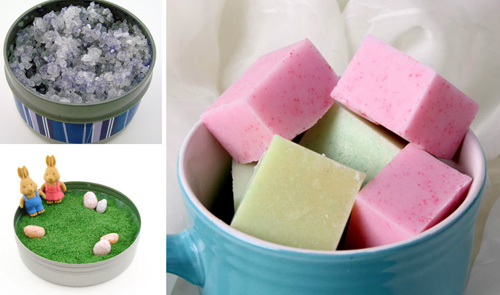 Top left, clockwise: Sea Salt Foot Scrub, Fruity Holiday Sugar Scrub, Simple Easter Scrub
Top left, clockwise: Sea Salt Foot Scrub, Fruity Holiday Sugar Scrub, Simple Easter Scrub
Jojoba beads not only add exfoliation, they also add color and interest. In particular, they are a great for when you want to give the illusion of sprinkles! Below, jojoba beads give a festive touch to the Cool Yule Peppermint Loaf. Jojoba beads act as sprinkles in the Foaming Bath Whip Frosting Cupcakes, Birthday Cake Loaf Soap and the adorable Doughnut Melt and Pour.
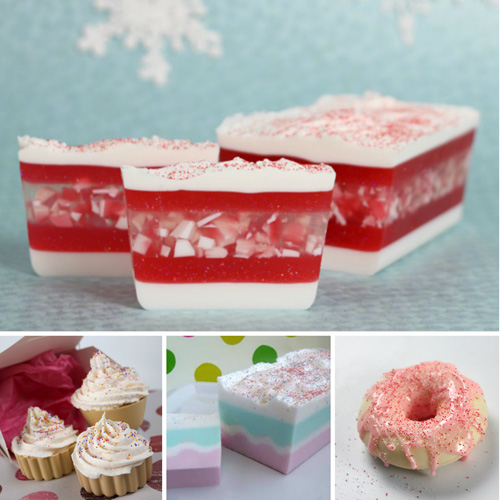 Top, clockwise: Cool Yule Peppermint Loaf, Foaming Bath Whip Frosting, Birthday Cake Loaf, Doughnut Melt and Pour
Top, clockwise: Cool Yule Peppermint Loaf, Foaming Bath Whip Frosting, Birthday Cake Loaf, Doughnut Melt and Pour
Jojoba beads can also be added into soap, providing gentle exfoliation in both melt and pour and cold process. In the Gardening Cold Process Soap, the jojoba beads exfoliate alongside coffee grounds and shredded loofah to create a super scrubby bar. The Easy Sea Turtle Soap Tutorial uses Forest Green Jojoba Beads to add a pop of color, while jojoba beads add interest to layers in the Carnation Cube Cuties. 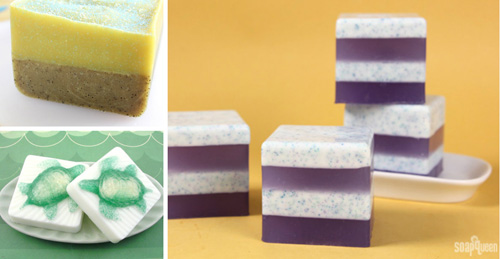 When embedding jojoba beads in melt and pour or cold process soap, temperature is key. Because jojoba beads are made from jojoba oil (which is technically a liquid wax, click here to learn more about jojoba oil), jojoba beads can melt if overheated. Jojoba beads should be added to melt and pour under 140 °F to be on the safe side. Below, the jojoba beads were added to melt and pour at 160 °F. As you can see, the jojoba beads have begun to melt!
When embedding jojoba beads in melt and pour or cold process soap, temperature is key. Because jojoba beads are made from jojoba oil (which is technically a liquid wax, click here to learn more about jojoba oil), jojoba beads can melt if overheated. Jojoba beads should be added to melt and pour under 140 °F to be on the safe side. Below, the jojoba beads were added to melt and pour at 160 °F. As you can see, the jojoba beads have begun to melt! 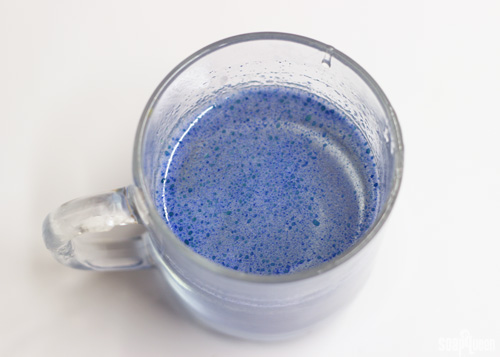 Temperature is also key in order to evenly suspend the jojoba beads in melt and pour. When melt and pour increases in temperature, it become a thinner consistency. When the soap is thin, the jojoba beads will begin to float to the top.
Temperature is also key in order to evenly suspend the jojoba beads in melt and pour. When melt and pour increases in temperature, it become a thinner consistency. When the soap is thin, the jojoba beads will begin to float to the top.
Pour melt and pour with added jojoba beads at approximately 120-125 °F. At this temperature the melt and pour will be a thicker texture. This thick consistency properly suspends the beads throughout the soap. Below, the soap on the right was poured at 140 °F, while the soap on the left was poured at 125 °F. A few degrees makes a huge difference!
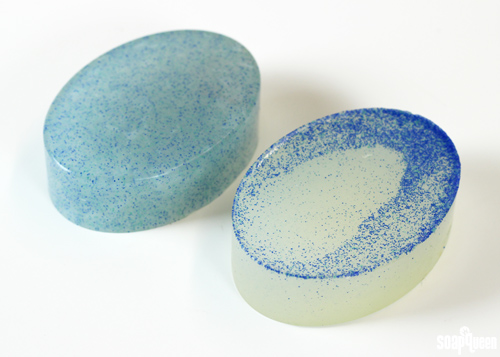 Have you used in jojoba beads in a project? I’d love to hear about your experience and thoughts regarding jojoba beads!
Have you used in jojoba beads in a project? I’d love to hear about your experience and thoughts regarding jojoba beads!
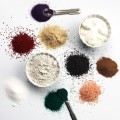
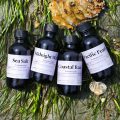
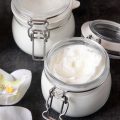
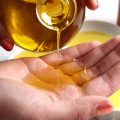
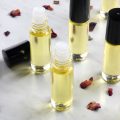
Hello,
I recently started experimenting with making shower gel using Castile Soap. I used 4 oz of Castile Soap (with added sodium borate for a natural thickener), 0.6 oz of fragrance oil and I added red jojoba beads. At first the mixture was a creamy beige spotted with beautiful red beads. After a few hours, I noticed the beads arose to the top (which I assume is from the oils floating to the top) and the soap turned an ugly grey and was very watery. I made a few others with different fragrance oil scents and no jojoba beads that stayed creamy and were quite a bit thicker. What made my castile soap turn grey in the bottle that had jojoba beads?
Hi Melanie!
Hmm, I’m wondering if it’s the fragrance oil. For 4 ounces of soap, we recommend about .1 ounces of fragrance for a strong scent. If the soap is more strongly scented, the fragrance may be separating and affecting those jojoba beads.
When you use the soap, did you notice any separation within the bottle? Let me know and we’ll get this figured out. 🙂
-Kelsey with Bramble Berry
Hi, Recently made a soap using your white jojoba beads. They seem to slowly dissolve when using the soap. Is this a correct impression? I’m thinking they do dissolve and add extra conditioning to skin. At any rate, I love them.
Hi Karen!
Jojoba beads can dissolve if they are added to soap that is 160F or hotter. If they stay cooler than that, they shouldn’t dissolve, but may melt a little when you use them in the shower. 🙂
-Kelsey with Bramble Berry
Are the coloring of the jojoba beads NATURAL? Or are they chemically colored?
Hi Tina!
Most of our jojoba beads are colored with oxides. Oxides are considered “nature identical” meaning they are the exact same chemical structure as the platelet minerals found in the earth. But they are created in a lab to ensure purity.
If you’d like to find out about a specific color of jojoba bead, each one will say in the description what it’s colored with.
If you prefer, we also offer other exfoliant options, like bamboo extract. 🙂
-Kelsey with Bramble Berry
Jojoba beads: https://www.brambleberry.com/Jojoba-Beads-C125.aspx
Bamboo powder: https://www.brambleberry.com/Bamboo-Extract-Powder-Light-Exfoliant-P3714.aspx
Hello Brambleberrians,
I loved using the multi mix jojoba beads on top of birthday style petit-fours (sweet thang and vanilla ) that I made for a wedding shower …
we all loved how they looked, found a few that had been bitten into by the brides neice, and absolutely loved how long they lasted and how amazing the scrubby jojobas felt when washing our hands…even my last 2 boys ( age 15 and 12 ) commented on what a great wash they had …lol.
I haven’t made them for a year ( since we had 5 varieties and 50 left over ) and definitely will be doing so again..in your multi cube soap trays…
perhaps chocolate /vanilla /peppermint patty for christmas?
this was M@P, btw.
laurie
Hi Laurie!
What a fun project! Sounds like it was a hit. 🙂
-Kelsey with Bramble Berry
Thank you so much for this jojoba bead information! I learn so much from all of you there at BB and you always give me such inspiration. I have so much to make!
Hi Gwendolyn!
So happy you enjoyed the post! Have fun soaping. 🙂
-Kelsey with Bramble Berry
Are these the same beads that are now being removed from products because of harm to the environment?
Hi Jeanine!
The micro-beads that are causing problems in the Great Lakes are made from plastic. So no, these aren’t the same thing, in fact Jojoba beads (along with walnut shells) are a great alternative since Jojoba beads are bio-degradable and sustainable! We just updated the post to make this fact more clear – thanks for bringing this to our attention and helping to improve the article!
-Kelsey with Bramble Berry
Maybe a dumb question,but… Do you factor the weight/volume of the beads as an oil when calculating lye for CP? I’ve not used jojoba beads, but they sound fascinating.
Hi Kim!
Jojoba beads are considered an additive, so you don’t have to factor them in when calculating your lye. You can start out with 1/4 tsp. to 1/2 tsp. per pound of soap, depending on how scrubby you want your soap to be. 🙂
-Kelsey with Bramble Berry